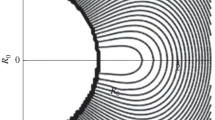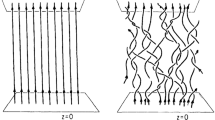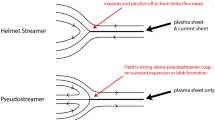Abstract
This paper is an exploration of the possibility that the large-scale equilibrium of plasma and magnetic fields in the solar corona is a minimum energy state. Support for this conjecture is sought by considering the simplest form of that equilibrium in a dipole solar field, as suggested by the observed structure of the corona at times of minimum solar activity. Approximate, axisymmetric solutions to the MHD equations are constructed to include both a magnetically closed, hydrostatic region and a magnetically open region where plasma flows along field lines in the form of a transonic, thermally-driven wind. Sequences of such solutions are obtained for various degrees of magnetic field opening, and the total energy of each solution is computed, including contributions from both the plasma and magnetic field. It is shown that along a sequence of increasingly closed coronal magnetic field, the total energy curve is a non-monotonic function of the parameter measuring the degree of magnetic field opening, with a minimum occurring at moderate field opening.
For reasonable choices of model parameters (coronal temperature, base density, base magnetic field strength, etc.), the morphology of the minimum energy solution resembles the observed quiet, solar minimum corona. The exact location energy minimum along a given sequence depends rather sensitively on some of the adopted parameter values. It is nevertheless argued that the existence of an energy minimum along the sequences of solutions should remain a robust property of more realistic coronal wind models that incorporate the basic characteristics of the equilibrium corona- the presence of both open and closed magnetic regions.
Similar content being viewed by others
References
Abramowitz, M. and Stegun, I. A. (eds.): 1972, Handbook of Mathematical Functions, Dover, New York, p. 228.
Aly, J. J.: 1984, Astrophys. J. 283, 349.
Aly, J. J.: 1991, Astrophys. J. 375, L61.
Bondi, H.: 1952, Astrophys. J. 112, 195.
Gibson, S. and Bagenal, F.: 1995, J. Geophys. Res. 100, 19685.
Hu, Y. Q. and Low, B. C.: 1989, Astrophys. J. 342, 1049.
Hundhausen, A. J.: 1996, in K. T. Strong, J. L. R. Saba, and B. M. Haisch (eds.), The Many Faces of the Sun: Scientific Highlights of the Solar Maximum Mission, in press.
Hundhausen, J. R., Hansen, R. T., and Hansen, S. F.: 1981, J. Geophys. Res. 86, 2079.
Kopp, R. A. and Holzer, T. E.: 1976, Solar Phys. 49, 43.
Linker, J. A. and Mikić, Z.: 1995, Astrophys. J. 438, 45.
Low, B. C.: 1986, Astrophys. J. 310, 953.
Low, B. C.: 1990, Ann. Rev. Astron. Astrophys. 28, 491.
Mestel, L. and Spruit, H. C.: 1987, Monthly Notices Roy. Astron. Soc. 226, 57.
Newkirk, G., Jr.: 1972, in C. P. Sonnet, P. J. Coleman, and J. M. Wilcox (eds.), Solar Wind, NASA Scientific and Technical Information Office, Washington, SP-308, p. 11.
Owocki, S. P., Holzer, T. E., and Hundhausen, A. J.: 1983, Astrophys. J. 275, 354.
Pneuman, G. W. and Kopp, R. A.: 1971, Solar Phys. 18, 258.
Sakurai, T.: 1985, Monthly Notices Roy. Astron. Soc. 152, 121.
Smith, D. F. and Low, B. C.: 1993, Astrophys. J. 410, 412.
Steinolfson, R. S., Suess, S. T., and Wu, S. T.: 1982, Astrophys. J. 255, 730.
Tsinganos, K. and Low, B. C.: 1989, Astrophys. J. 342, 1028.
Washimi, H. and Shibata, S.: 1993, Monthly Notices Roy. Astron. Soc. 262, 936.
Wang, A.-H., Wu, S. T., Suess, S. T., and Poletto, G.: 1993, Solar Phys. 147, 55.
Weber, E. J. and Davis, L., Jr.: 1967, Astrophys. J. 148, 217.
Withbroe and Noyes: 1977, Ann. Rev. Astron. Astrophys. 15, 363.
Zirker, J. B.: 1977, in J. B. Zirker (ed.), Coronal Holes and High Speed Wind Streams, Colorado Associated University Press, Boulder, p. 1.
Author information
Authors and Affiliations
Additional information
The National Center for Atmospheric Research is sponsored by the National Science Foundation.
Rights and permissions
About this article
Cite this article
Charbonneau, P., Hundhausen, A.J. The solar corona as a minimum energy system?. Sol Phys 165, 237–256 (1996). https://doi.org/10.1007/BF00149713
Received:
Revised:
Issue Date:
DOI: https://doi.org/10.1007/BF00149713




